Another paddler – a complete stranger, in fact – once described me as “bristling” with safety gear. While I thought that was a bit much (“festooned,” maybe, but hardly “bristling”), I certainly do consider myself to be safety-conscious – which is partly why I’ve always been a strong proponent of deck bags.
Although I always keep several meteor flares, a strobe, a mirror, and knife on my PFD, I also insist on having my two-way radio, a few extra meteor flares, sometimes a parachute flare and even, depending on circumstances, an EPIRB, within easy reach.
A deck bag functions as a single, secure repository for this stuff, along with things of much more frequent but less pressing need, such as snacks and water.
For years I used a simple and inexpensive nylon deck bag that kept my gear together and readily accessible, but did nothing to keep water out. Anything inside that could be damaged by moisture was in a ziplock bag or waterproof case.
This worked okay, but it was awfully fussy at times. If I wanted, say, the bird guide to which I refer frequently, I had to open the deck bag, fish out the ziplock containing the book and open that, and stuff the ziplock back in the bag so it wouldn’t blow away, by which time the black-browed albatross I swore I’d spotted was long gone.
In addition, while the deck bag didn’t do much to keep water out, it seemed remarkably efficient at keeping it in. One dumping wave early in the morning was sufficient to keep the contents of the bag damp all day.
Photography was also a pain. Since I use 35mm SLR equipment, dry storage is essential-but so is fast access. One morning on the Sea of Cortez, I had just spotted several whales coming my way, running with the brisk tidal flow that surges past the midriff islands.
My camera was in a roll-top dry bag bungied on top of the deck bag, along with a wide-angle zoom and a short telephoto. The longer lens I figured I’d need was in a small case behind me. I parked my paddle and pulled both bag and case on top of the spray skirt while the sound of spouting drew nearer and nearer. I opened the waterproof case, opened the dry bag, juggled lenses, and that’s when a big fin whale rolled out of the water and blew, headed straight toward me not 30 feet away.
Gee, I guess I didn’t need that long lens after all.
All I could do was hang on to my $2,000 worth of exposed equipment while the boat rocked in the whale’s wake and a fine mist smelling of chum settled over me. There had to be a better way.
The solution to all this seemed obvious. When I got home I called around the country, but no one had anything like what I described, nor did anyone seem too keen on making something to my order.
That was several years before the first completely waterproof deck bags became widely available. Now, at last, the idea seems to have caught on. There are several completely waterproof models around, and a number of what you might call “sort-of” waterproof versions-water-resistant bags utilizing zippers that will keep out most water short of a dumping wave or a dunking.
I’ve been using a waterproof deck bag now for five years, with totally satisfactory results-which is to say, I haven’t drowned a camera yet. My bird book is right there when I need it, along with a bunch of other things freed from their baggies.
I feel better having my waterproof binoculars and VHF radio away from constant salt-water exposure.
Un-soggy granola bars are just a bonus.
However, make sure you have your priorities straight before buying one of these bags and chucking vulnerable electronics inside. I am constantly aware that there is just one layer of protection between the ocean and my camera’s 6-volt innards.
If it’s raining or the sea is rough, I not only can’t get my camera out, I can’t open the deck bag to get anything else in it. If you want to use a waterproof deck bag in all conditions, think of it as a secondary layer of security: Anything likely to get damaged by water gets ziplocked first and then put inside.
A deck bag leads a much harder life than the dry bags you carry in the cargo holds. It is constantly exposed to splashing, and often to strong dumping waves. The sun beats down on it, leading to ultraviolet deterioration, and it is subject to abrasion from paddles and botched landings.
So the choice of materials and the quality of construction are of vital importance if you expect to maintain watertight integrity. So is maintenance: I carefully inspect my deck bag before every use by holding it up to the light and looking for leaks, and I make sure the zipper is well-lubricated and free of debris.
I tested the five bags reviewed here first in normal, boat-mounted usage. Afterwards I lined them up and subjected each to a thorough dousing with a hose, trying in particular to squirt water past the zipper.
Then I completely dunked each one in a tub and held it there for 30 seconds-a longer immersion than one would expect from a capsize and roll.
Watershed’s Aleutian
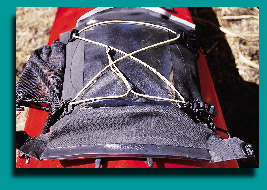
The quality of Watershed’s products never fails to impress me, and the Aleutian continues the tradition that began with the company’s bombproof duffels and dry bags.
The Aleutian is made from an extremely strong polyurethane-coated nylon fabric, with seams that are radio-frequency welded rather than glued. Polyurethane has a couple of advantages over the less expensive and more common PVC (polyvinyl chloride) or simpler urethane coatings.
Watershed says polyurethane has four times the abrasion resistance of PVC, a claim I have no reason to doubt after abusing both materials. Just as importantly, the polyurethane coating, which is embossed with a fabric-like pattern on the outside of the Watershed bags, creates a very slick finish, unlike the slicker-looking but grabbier PVC.
If you poke a PVC-coated bag at an angle with the point of a knife (simulating any number of sharp objects that might accidentally poke it in real life), it tends to dig in, whereas on the polyurethane it’s more likely to skid off, decreasing the chances of a puncture.
Polyurethane is supposed to remain more flexible in cold weather, although the Sea of Cortez, even in January, was no place for me to confirm this. Finally, polyurethane application is a more environmentally benign process than PVC. (The same holds true for welding seams instead of gluing them.)
Watershed’s closure system resembles an oversized ziplock closure, with fat rubber lips you squeeze together, and two tabs that you pull apart to open it. It’s much easier to operate than a dry suit-type zipper, yet appears to be, for all the intents and purposes of a deck bag, just as waterproof.
No matter how hard or at what angle I squirted it, the contents remained dry. Same with the dunk test and while paddling. However, you must make absolutely certain that the lips are sealed along their entire length, or leakage is inevitable.
Watershed lists the volume of the Aleutian as four gallons-an amusing choice of measurement for something that’s supposed to be waterproof-or 989 cubic inches.
That’s a useful size; however, the Aleutian is built in a flat, envelope configuration, and there are no stiffeners to hold it open, so access is not the best. Also, my sample was a deep black color, so the interior was very dark (and hot), making it difficult to see the contents. I’d suggest buying a lighter color.
The bag has a clear chart window on top, underneath which is a pocket where a chart can be inserted; the chart is inside the bag so it always stays dry and in place.
The window is made from tough and highly UV-resistant urethane rather than PVC; nevertheless, it’s surely not as puncture-resistant as the main body and must be considered the weak point. If this were changed to a separate chart case on top of the bag, overall integrity would improve and you could remove the case to get a better look at the chart. [Editor’s note: After the bag was returned by the reviewer, we found that the flap that supports the chart hangs down into the bag. The flap tore easily when pushing gear into the bag.]
A mesh water bottle pocket is on the left exterior; on the right is a very secure holder for a standard cylindrical bilge pump. Finally, the front of the bag is bound with reflective tape that shows up well at night.
Mounting the Watershed bag revealed some deficiencies in the design. First, it’s a wide bag, so its mounting straps could barely be shortened enough to fit on the deck of a 22-inch-wide kayak. More importantly, with the straps pulled tight, it’s impossible to open the bag wide enough to put anything three-dimensional inside.
You have to leave the straps very loose to insert a camera. If the straps were welded to the bag somewhat underneath instead of right at the sides (or if the bag were built with an arched top panel), this problem would disappear. Also, the included strap hooks appear to be designed to clip over the deck bungies, a poor choice of attachment in my opinion. I would replace the hooks with narrower versions that would clip to the deck eyelets, or just tie short nylon cord loops through the eyelets and clip to those.
The Watershed Aleutian has a lot of thoughtful features. It could use a tweak to the mounting system or shape, and perhaps a removable stiffener to ease access.
Price: $110
Voyageur’s Half Dome
The Half Dome incorporates a polyethylene sheet stiffener that gives it a rounded profile-and makes accessing the contents a cinch. The bag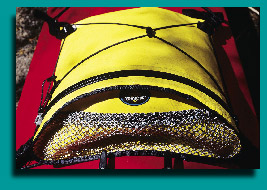 is made from PVC-coated polyester in a simple, tapered shape, with no external pockets, save a mesh one at the rear big enough for sunscreen or a small water bottle. The bungies running across the top will secure (not very well) a chart in a ziplock.
is made from PVC-coated polyester in a simple, tapered shape, with no external pockets, save a mesh one at the rear big enough for sunscreen or a small water bottle. The bungies running across the top will secure (not very well) a chart in a ziplock.
The Half Dome utilizes a serious dry suit-type zipper closure that arcs over the rear end of the bag. When it’s open you can pull the rear flap down and easily see and retrieve everything inside the 900-cubic-inch bag. As I expected, there was no leakage under any circumstances. As with all examples of this type of zipper, however, it is quite stiff to operate. This is somewhat reassuring, since you know when the thing is closed, unlike on, say, the Watershed where you have to feel all along the edge of the lips to make sure you’ve popped every bit shut. But the zipper requires a strong pull, which would be much easier if Voyageur added loops at either end of the opening to hook a thumb through while pulling with the other hand.
The Half Dome has the best wave-shedding profile of the bunch. Although its tapered front more easily scoops up small waves coming along the deck than the bags with bluff fronts, which block them, those waves and even bigger ones usually cascade harmlessly off the back of the Voyageur bag. When bigger waves hit the front of the blunt bags, they tended to splash up in my chest and face more.
The Half Dome’s compact shape and 14-inch width fit well on the deck of nearly any kayak. The mounting kit comprises four web straps with plastic clips on one end (like the Watershed, apparently designed to clip to bungies), and sewn loops on the other. If you slid these loops over the bungies that are laced across the bag, you would have an easily adjustable but pretty elastic bungie-to-bungie mount. However, try as I might I couldn’t disassemble the dang fitting that connects the ends of the bungie on the bag, so I couldn’t slide the loops on, short of cutting the bungie and retying it. If this were my bag, I’d ignore the whole setup, and use nylon cord and clips to tie the bag down by its four stout corner eyelets. I think this would be much sturdier in any case. Even with the corners pulled tight, the arched top makes it easy to insert and retrieve gear.
Overall, there was very little to criticize about the Voyageur bag. I worry a bit about the polyethylene sheet abrading the bag from the inside. I’d like to see reinforcing patches where the corners of the sheet rub. I’d wrap the edges of the sheet with tape or foam, but that’s quibbling. The Half Dome is simple, easy to use, and totally waterproof, at a very reasonable price.
Price: $90 | Voyageur
Cascade Designs’ Aleutian
The Aleutian employs a YKK zipper that appears to be one step down from the heavy duty dry suit integrity of the Half Dome’s version. It’s not as stiff to operate, but could still use a couple of grab loops on the bag to hold on to. It passed all my tests with no leakage whatsoever.
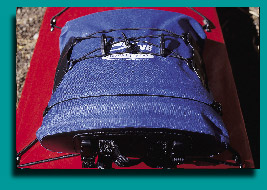 The Aleutian is made from urethane-coated Cordura nylon, with welded seams. The bag is stiffened with a polyethylene sheet into a flattened ovoid shape that uses all of its modest 620 cubic inches efficiently. The zipper arcs over the top of the bag about three inches from the rear, so the back doesn’t fold down like a flap-you have to just push down on it to access the inside. Still, it works fine, and there’s a fabric flap that covers the zipper to help keep out grit. The bag is tall enough to hold my SLR camera (if I leave off the motor drive), and wide enough for a couple of extra lenses, plus a field guide and snacks-in other words, it has all the room you’re likely to need. Yet at only 12 1/2 inches wide (compared to 20 for the Watershed, including the clips), it’s compact enough to fit any deck.
The Aleutian is made from urethane-coated Cordura nylon, with welded seams. The bag is stiffened with a polyethylene sheet into a flattened ovoid shape that uses all of its modest 620 cubic inches efficiently. The zipper arcs over the top of the bag about three inches from the rear, so the back doesn’t fold down like a flap-you have to just push down on it to access the inside. Still, it works fine, and there’s a fabric flap that covers the zipper to help keep out grit. The bag is tall enough to hold my SLR camera (if I leave off the motor drive), and wide enough for a couple of extra lenses, plus a field guide and snacks-in other words, it has all the room you’re likely to need. Yet at only 12 1/2 inches wide (compared to 20 for the Watershed, including the clips), it’s compact enough to fit any deck.
The mounting system of the Aleutian consists of two fat Velcro strips across the bottom, which you slide under your deck bungies. It’s not very stable this way; however, when I tied non-elastic nylon cord in an X between my deck fittings and fastened the strip under those, the bag didn’t move around as much. It has the advantage of adapting easily to various deck layouts, but I still wish the bag had D-rings at the corners so you could make your own more rigid attachment system.The Aleutian has no frills aside from bungies and a pair of clips on top to secure your chart case or small items.
In short, the Cascade Designs Aleutian is a versatile and efficiently sized deck bag that will fit a wide variety of boats, including narrow Greenland styles.
Price: $120 | Cascade Designs
Seattle Sports’ Sea Kayak Deck Bag
The Seattle Sports bag is a monster at 1200 cubic inches, yet at 15 inches in overall width it will still fit on most decks. This bag held all my normal deck bag stuff, plus a one-liter water 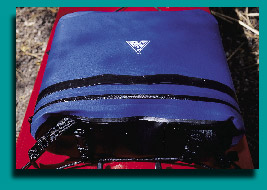 bottle, and still had room for my Gore-Tex shell when the morning turned warm. A stiffening sheet maintains the bag’s shape (and, as with most of these bags, is removable if you don’t want it).
bottle, and still had room for my Gore-Tex shell when the morning turned warm. A stiffening sheet maintains the bag’s shape (and, as with most of these bags, is removable if you don’t want it).
I did not, however, put unprotected cameras inside. The Seattle Sports bag uses a YKK “Hydro-Kiss” weatherproof zipper which will fend off minor splashes and light rain, but is not waterproof. There was about a tablespoon of water inside after both hosing and dunking-although, to be fair, after a paddle in bouncy conditions the inside was quite dry. Still, this product is not intended to be waterproof. The fabric on the bag is a strong, urethane-coated, 400-denier nylon with welded seams, so no water is likely to get in that way.
This bag’s attachment system was the simplest and most adaptable. Nylon straps near each corner can be looped around bungies or through deck eyelets, or be substituted with your own hardware.
Given its large size but low profile, and versatile mounting system, the Seattle Sports bag would also be useful as a behind-the-cockpit bag for items such as outerwear, hats, and gloves, which you’d like to keep mostly dry but which won’t be harmed by a little water.
Price: $60 | Seattle Sports
Salamander’s Sea Kayak Deck Bag
With a zipper similar to that used on the Seattle Sports bag, the Salamander bag was similarly water resistant. PVC-coated nylon keeps the body of the bag waterproof, so only direct splashing or steady rain (or, of course, immersion) results in water inside. As with the 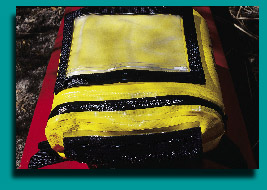 Seattle Sports model, the inside of the Salamander bag stayed dry during what I’d call a fair-weather paddle-light breezes and small waves. I could have had a field guide inside with no worries. But when subjected to direct spraying or dunking the zipper leaked a small amount of water almost immediately, mostly through the small gap visible at the end of the zipper track.
Seattle Sports model, the inside of the Salamander bag stayed dry during what I’d call a fair-weather paddle-light breezes and small waves. I could have had a field guide inside with no worries. But when subjected to direct spraying or dunking the zipper leaked a small amount of water almost immediately, mostly through the small gap visible at the end of the zipper track.
For its extra $25, the Salamander bag adds some nice touches compared to the unadorned Seattle Sports model: There’s a zippered mesh pouch on the back and an excellent chart case on top, secured with turn buttons. It’s a matter of a second or two to remove the case to get a better look at your chart.
A (non-removable) polyethylene sheet holds the shape of the deck bag, and the zipper is near the back so the opening flaps down out of your way. Salamander didn’t have a figure for volume, but by my own rough measurements it appears to be similar in size to the Voyageur bag-around 900 cubic inches. Overall width is 13 inches, so fit shouldn’t be a problem on most boats.
Mounting the Salamander bag is straightforward, using four nylon straps that radiate from a reinforced patch on the bottom; they should adapt to almost any kayak deck arrangement.
On my own 22″-wide boat I was able to loop the straps through short lengths of cord tied through my deck eyelets, and the result was very rigid, although waves do get under the bag and flop it around somewhat. This bottom mounting system can’t constrict access to the contents like the Watershed mount. There was a lot to like about the Salamander, as long as you keep its design limits in mind when you load it.
Price: $84.50 | Salamander Paddle Gear
The idea of semi-waterproof deck bag models initially seemed strange to me, but they do eliminate the dampness common with cheaper deck bags. While I’ll probably continue to put my faith in that single layer between the sea and a short circuit, there’s no doubt that even the semi-waterproof models add significant protection to any bagged item inside.

